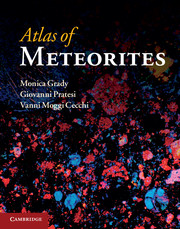Book contents
- Frontmatter
- Contents
- Foreword and acknowledgements
- Institutions that provided specimens
- 1 Introduction
- 2 Carbonaceous chondrites
- 3 Ordinary chondrites
- 4 Enstatite chondrites
- 5 Rumurutiite and Kakangari-type chondrites
- 6 Acapulcoites and lodranites
- 7 Brachinites
- 8 Winonaite–IAB–IIICD Clan
- 9 Ureilites
- 10 Angrites
- 11 Aubrites
- 12 Howardite–eucrite–diogenite clan
- 13 Mesosiderites
- 14 Pallasites
- 15 Iron meteorites
- 16 Lunar meteorites
- 17 Martian meteorites
- Index of meteorites by name
6 - Acapulcoites and lodranites
Published online by Cambridge University Press: 11 November 2021
- Frontmatter
- Contents
- Foreword and acknowledgements
- Institutions that provided specimens
- 1 Introduction
- 2 Carbonaceous chondrites
- 3 Ordinary chondrites
- 4 Enstatite chondrites
- 5 Rumurutiite and Kakangari-type chondrites
- 6 Acapulcoites and lodranites
- 7 Brachinites
- 8 Winonaite–IAB–IIICD Clan
- 9 Ureilites
- 10 Angrites
- 11 Aubrites
- 12 Howardite–eucrite–diogenite clan
- 13 Mesosiderites
- 14 Pallasites
- 15 Iron meteorites
- 16 Lunar meteorites
- 17 Martian meteorites
- Index of meteorites by name
Summary
Introduction
Acapulcoites and lodranites are igneous rocks recognized as a family (or clan) of primitive achondrites that have common mineralogical, petrographic and geochemical features. In the last decade, there has been a substantial growth in the number of family members: according to the Meteoritical Bulletin, not accounting for pairing, there are currently (June 2014) 58 acapulcoites, nine meteorites transitional between the two groups, 48 lodranites and one anomalous lodranite (Y 74357) (www.lpi.usra.edu/meteor/metbull.php). There is one acapulcoite fall (Acapulco) and one lodranite fall (Lodran); these are the type specimens of the two groups within the acapulcoite–lodranite clan. Although the bulk composition of members of the acapulcoite–lodranite clan resembles that of ordinary chondrites, textural and mineralogical evidence suggest a gradation in the degree of heating of their parent body, from acapulcoites that contain relict chondrules to lodranites that have lost sulphide and feldspathic (plagioclase-bearing) melt [6.1, 6.2].
Some of the criteria originally proposed for discriminating between acapulcoites and lodranites were too limited to encompass meteorites transitional between the endmembers [6.3], leading to the proposal of other classification schemes [6.4, 6.5]. On the basis of mineral chemistry, the meteorites can be divided into one group of acapulcoites and two groups of lodranites [6.4]: magnesian lodranites (Gibson, Y 75274 and Y 8002) and ferroan lodranites (all other lodranites). An alternate classification [6.5], based on K and Se abundances (Figure 6.1), recognized subtypes related to thermal history: primitive acapulcoites with near chondritic elemental abundances; typical acapulcoites characterized by incipient melting and loss of sulphide phases; transitional acapulcoites marked by a deficit of sulphides and melting or loss of plagioclase; lodranites with subchondritic elemental abundances and depletions in troilite, metal and plagioclase; and enriched acapulcoites with a clear addition of feldspar probably resulting from trapping of partial melt lost from lodranite regions [6.5, 6.6].
Mineralogy
Much of the information in the following sections is drawn from the review by Mittlefehldt et al. [6.7], and references therein. Mineralogical characteristics of the type meteorites Acapulco and Lodran can be employed to distinguish between acapulcoites and lodranites.
- Type
- Chapter
- Information
- Atlas of Meteorites , pp. 200 - 214Publisher: Cambridge University PressPrint publication year: 2013

